It was the season of the smiling bank manager. The Wollastons had an account at the new Mildred Bank, run by a shock-haired young Missourian named Hayden Bright, who raced around the countryside in an open Ford tourer, accompanied by his jackrabbit-chasing brindled English bulldog, and pressed loans on his clients. All the homesteaders were undercapitalized, and it was the banker's pleasant duty to lend them the means to buy the stock, the seed, the machinery needed to bring them into certain profit. Percy remembered Hayden Bright warmly, for his friendliness, his memory for children's names, bullet-speed driving and his crazy dog. Once, during a small agricultural crisis, Hayden—as even young Percy knew him--passed a new checkbook across his desk, saying, "Take this and don't come back until you've got some hogs. And when you write out the check, don't act timid. Write 'er out as though you had all the money in the world."
The bank lending rate was 5 ½ percent. $55 per annum on $1,000. Or, say, an acre and a half of next year's wheat, set against a brand-new gas-engined tractor, which could double, or triple, one's workable acreage. It was cheap money, and it was logical, inevitable, unturndownable money. There was almost no loan so large that it would not pay for itself handsomely within a farming year. Hayden Bright and the other local bank managers saw themselves as cashing in on the homesteaders' success, and in their turn they too borrowed up to the hilt, to get as big a share of this surefire farm business as they possibly could. The homesteader had his milk cow; the banker had a milk cow in the shape of the homesteader; and so the line of credit stretched back eastward, to investors in Boston and New York who'd read the brochures, and wanted a slice of the brilliant future of the West.
Bad Land by Jonathan Raban
Since the settling of Lyon County, Minn., and Marshall, its principal city, farmers and merchants used bank credit to help realize their aspirations, just as Hayden Bright assisted homesteaders in eastern Montana. Thus, this Minnesota community's story is incomplete without considering banks' role. They financed the farmers and merchants who settled the region and continued to provide funds as the county's economy grew and diversified. As the county's economy has changed, so has its banking. Of the 18 Lyon County banks in operation in 1916, only the State Bank of Taunton has not changed its name, closed, merged or acquired branches.
Moreover, bank deposits and loans in Lyon County and Marshall provide insights into the epic events that shaped their history. Although this study focuses on banking numbers, banking in Lyon County, like other aspects of its history, is ultimately a story of the county's people.
This chronicle of banking in Lyon County and Marshall is divided into four sections. Banks' unique contribution to a local community's economic development will be reviewed. Then, banking data's usefulness, especially in Minnesota, for enhancing a community's history will be explained. Next, the history of banking in Lyon County will be recounted. Finally, deposit and loan data will be related to key developments in Lyon County and Marshall.
Communities' Economies Evolve
Lyon County was never intended to be a self-sufficient economic unit. Instead, it was established to produce agricultural products and trade them for other goods and services. Specialization and trade are the mainsprings of economic growth, for they allow a community to do what it does best. Communities' economies, however, change as new technologies and tastes alter markets. Thus, to remain viable local economies must continually reinvent themselves, and Lyon County is no exception.
The arrival of the railroads late in the 19th century enabled Lyon County settlers to move agricultural products into regional and national markets, and led to establishment of Marshall and other Lyon County communities. Shortly after the county was settled, however, the automobile, truck and tractor brought efficiencies that increased farm size and encouraged population to move to the county's major population centers, like Marshall. Besides bolstering its importance as a regional trade center, Marshall branched into processing and distributing food products when Louis Weiner and sons began Marshall Produce Co. in 1915, and became the center for higher education in southwest Minnesota with the establishment of Southwest Minnesota State College in 1967.
Banks Crucial to Lyon County's Growth
Banks had a critical role in supporting new and old businesses as Lyon County and Marshall transformed their economies. "According to Joseph Schumpeter, bankers are the gatekeepers—Schumpteter's word is 'ephor'—of capitalist economic development; their strategic function is to screen potential innovators and advance the necessary purchasing power to the most promising. They are the source of purchasing power for investment and innovation, beyond the savings accumulated from past economic development," writes economist James Tobin.2
Along with being a gatekeeper for investment opportunities, banks have provided a vital link between Lyon County and regional and national economies. Bartering exports for imports would be cumbersome. Instead, goods and services can be exchanged for money, which can be exchanged for other goods and services. Bank services, particularly checking accounts, facilitate commercial transactions within and between communities.
Also, banks serve as an equilibrating mechanism, sending funds out of a community when investment opportunities are meager and importing funds when investment opportunities exceed a community's resources.
Banking Data Embellish Lyon County's Story
Besides banks' prominence in fostering growth, they generate data that trace Lyon County and Marshall's growth. History is "a chronological record of significant events (as affecting a nation, institution) usually including an explanation of their causes," according to Webster's Seventh New Collegiate Dictionary.3 Putting together this chronology is somewhat like building a boat. The first step is building the keel, and the rest of the boat is built up from it. In the case of local history, population often serves as a very sturdy keel. Banking data reinforces that metaphorical keel when compiling a local or community history.
Until the late 1970s Minnesota prohibited branch banking, so banks primarily served the community where they were located, and a strong linkage existed between banking data and a community's economic performance. Banking deposits reflect a community's wealth, and changes in them should roughly mirror changes in a community's output and income. Plus, loan-to-deposit ratios indicate the extent to which funds are employed within a community. Just as a forester looks at rings in the cross-section of a tree to see how weather affected its growth, annual banking data provide insights on the impact of changing economic conditions on a community.
Lyon County banking data for 1914-1980 came from the Bank Directory for the Ninth Federal Reserve District, which Commercial West published for many years. Deposits, however, were not available for 1919-1920, 1923, 1926 and 1928-1932. In the 1980s banks began branching into and out of Lyon County, and the Federal Deposit Insurance Corp.'s (FDIC) Report of Deposits, which tabulates bank deposits by branch, was used to track Lyon County deposits.4 Deposit data are presented in 1999 dollars, as prices were about 15 times higher in 1999 than in 1914.5
The Railroads Brought Banks to Lyon County, and Shortly Thereafter Harsh Times Decimated Lyon County Banks
As the railroads advanced across Minnesota after the Civil War, Lyon County was settled. In the 1870s the Winona and St. Peter Railroad Line founded Marshall. In 1878 two banks were organized in Marshall—Bank of Marshall and Lyon County Bank (in 1891 it became the Lyon County National Bank). Then, in 1888, the Great Northern Railroad placed a line through Marshall. In 1891 the First National Bank of Marshall was established, and absorbed the business of the Bank of Marshall which was disbanded the prior year. Marshall State Bank was organized in 1909. Other Lyon County communities established banks, and by 1916, there were 18 banks in nine Lyon County communities. (Appendix 1 is a chronology of banking in Lyon County.)
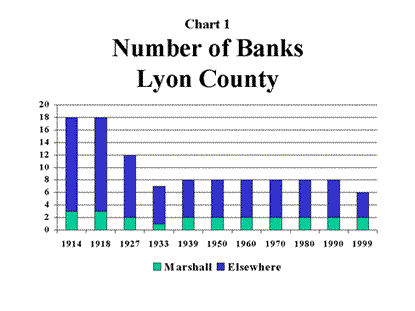
Over the next 16 years harsh economic conditions forced many of these banks out of business. Between 1919 and 1921 prices for wheat, a major crop in Lyon County at that time, fell more than 50 percent, and by 1927 Lyon County lost six banks. Marshall and Tracy went from three to two banks; Balaton, Ghent and Russell went from two banks to one bank; and the only bank in Lynd closed.
Wheat prices remained low and at the end of decade the Great Depression put additional strains on the Lyon County economy. And by 1933 only seven banks were still open. Cottonwood, Marshall, Minneota and Tracy went from two banks to one bank and the only bank in Ghent closed.
Lyon County Banks Affiliated with Large Banking Organizations in the 1930s
Along with economic travails of the 1920s and 1930s came a major change in banking structure in the Upper Midwest. Large Minneapolis and St. Paul banks connected Upper Midwest rural banks with regional and national economies, and rural banks increasingly came to recognize their interdependence with them. At the same time, the large Twin Cities banks were worried about Chicago and New York challenging their preeminence in the Upper Midwest.
Thus, in 1929 two large banking groups, or bank holding companies, were formed: First Bank Stock Corp. and Northwest Bancorporation. "In union there is strength," wrote Charles Sterling Popple in his study "Development of Two Bank Groups in the Central Northwest."6 First Bank Stock Corp. was renamed First Bank System, Inc. and is now part of U.S. Bancorp. Northwest Bancorporation was renamed Norwest Corporation and is now part of Wells Fargo & Co.
In several ways rural banks benefited from affiliating with these banking groups. They provided outside resources to support the bank. No market existed for the stock in rural banks, and by affiliating and exchanging their stock for bank holding company stock, rural banks acquired a market for their stock. Rural residents, however, were concerned about losing local control over their banks. To allay this fear, affiliating banks were allowed to keep their existing management and directors. The success and importance of these banking organizations is reflected in the fact that by 1940 First Bank Stock Corp. and Northwest Bancorporation controlled 54 percent of the deposits in the Ninth Federal Reserve District.7
Moreover, rural banks in Lyon County and elsewhere sought to shelter themselves from the deepening Depression by affiliating with these banking groups. In 1930 the First Bank Stock Corp. acquired the Farmers and Merchants State Bank of Minneota. In 1931 Northwest Bancorporation acquired the First National Bank of Marshall and the Farmers and Merchants State Bank of Tracy.
Otto Bremer, a St. Paul banker, also established a chain of country banks, and in 1935 his financial backing led to the establishment of the Western State Bank in Marshall. In 1943 he consolidated his rural holdings into the Otto Bremer Co., a bank holding company. Western State Bank is now Bremer Bank, N.A., an affiliate of the Bremer Financial Corp.
Branching Brought Major Changes to Banking in Lyon County
The banking structure of Lyon County remained essentially unchanged until the late 1970s when Minnesota began relaxing restrictions on branch banking. In the late 1970s the First Northwestern National Bank of Marshall opened a branch on the east side of Marshall. Then, in the late 1980s, the Norwest affiliate in Worthington became a branch of the Marshall bank. The bank is now named Norwest Bank Minnesota Southwest, N.A.
In 1981, the First State Bank of Minneota opened a branch in Marshall. In 1983 its name was changed to First Bank Southwest and its headquarters were moved to Marshall, with the Minneota office becoming the branch. In 1988 it was sold to Community First Bankshares. Inc., a bank holding company headquartered in Fargo, N.D., and renamed Community First National Bank of Marshall. In the mid-1990s it was merged into other Community First Banks, and the two Lyon County offices are now branches of Community First National Bank, Fergus Falls.
The Cottonwood and Russell banks in Lyon County have opened offices in Marshall. In 1997, the United Southwest Bank in Cottonwood opened a branch in Marshall. It also has branches in Hanley Falls and Vesta. In 1995, the First Independent Bank in Russell opened a branch in Marshall.
Two banking organizations outside the county also have branches in Marshall. In 1996 Minnesota Valley Bank in Redwood Falls opened a branch in Marshall. Pipestone Federal, a savings and loan (S&L), opened a branch in Marshall in 1976. It was merged into Twin City Federal, a Minneapolis S&L, which converted to a commercial bank in the 1990s. In 1998 Twin City Federal sold its Marshall branch to the United Prairie Bank-Slayton.
Outside Marshall, 21st Century Bank in Balaton had opened a branch in Tracy in the early 1980s. In the late 1990s, the First Independent Bank of Russell acquired Balaton office of the 21st Century Bank. The Tracy branch became part of the 21st Century Bank of Rogers. Also, in 1999 the Tracy State Bank opened another office in Tracy.
Thus, today six banks have Lyon County headquarters compared with 18 in 1916. However, when branches are included, 16 banking offices are open in Lyon County—not much different from 1916. Eight of these banking offices are in Marshall. Moreover, 91 percent of banking deposits within Lyon County are in banks either with headquarters outside the county or affiliates of bank holding companies with headquarters outside the county. Brokerage firms, credit unions and the Farm Credit System also provide credit services in Lyon County.
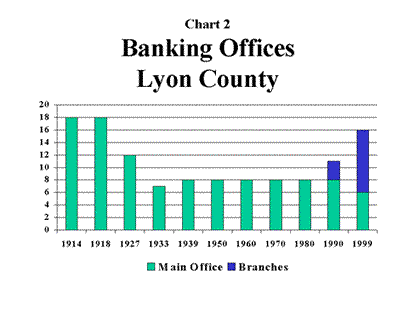
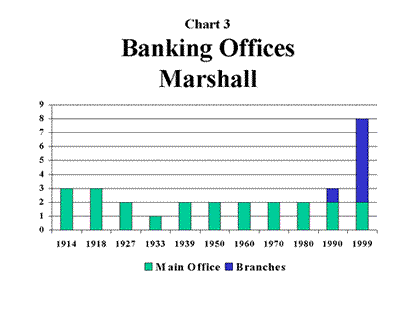
Charles S. Popple in his "Development of Two Bank Groups in the Central Northwest" describes two schools of thought on banking developed in Upper Midwest rural communities: the effusionist and diffusionist. "According to the effusionist school, institutions arise out of the local situation, rise, fall and rise again, with but little copying from earlier systems. The diffusionist school believes that ideas and practices flow from one area to another, there is little originality, and much copying."8
Popple believed the effusionist school typified the development of Upper Midwest banking, and the changes banking in Lyon County are consistent with Popple's observation. Revisions in banking legislation, development of new financial services and changes in the national economy undoubtedly changed Lyon County banking. Demographic and economic changes also strongly shaped the configuration of its banks, as Lyon County diversified away from agricultural production to food processing and distribution, and then to higher education. Reflecting these changes' pervasiveness, only the State Bank of Taunton, out of the 18 Lyon County banks in operation in 1916, has not changed its name, closed, merged or acquired branches.
Bank Deposits Chart Lyon County and Marshall's Growth
While over the last 85 years Lyon County's banking structure has changed considerably, the deposits these banks attracted enrich the story about how Lyon County and Marshall developed in the 20th century. Between 1914 and 1918, Lyon County boomed as World War I boosted both agricultural prices and bank deposits, adjusted for price changes. (Appendix 2.xls contains deposit data.)
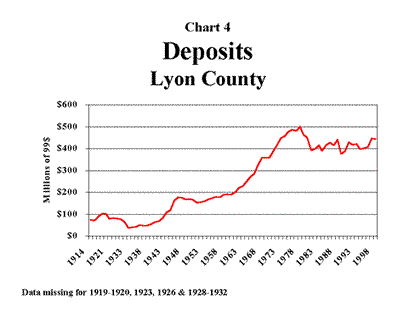
Between 1918 and 1921 bank deposits fell 21 percent as world agricultural prices tumbled after World War I. The farm depression continued through the 1920s, and then in 1929 the Great Depression hit. By 1933, Lyon County deposits were 64 percent below their 1918 high. Not until 1943 did Lyon County deposits surpass deposits held in 1918.
After World War II deposit growth tapered off, and did not start growing until the 1960s when Southwest Minnesota State College opened in Marshall, and in the 1970s deposit growth jumped along with another surge in agricultural prices. In the 1980s a decline in agricultural prices depressed deposit growth. After agricultural prices improved in the late 1980s and early 1990s, however, deposit growth did not resume as Lyon County residents increasingly used nonbank financial institutions as a repository for their funds.
Meanwhile, Marshall was capturing an increasing share of the county's bank deposits. In 1914, Marshall was the area's regional trade center and the county seat with 30 percent of the county's deposits. It started diversifying into food manufacturing in 1915 when Louis Weiner and son formed Marshall Produce Co. But declining farm prices and the Great Depression halted Marshall's economic advance, and its share of county bank deposits declined until 1933. During the remainder of the 1930s and into the 1940s its growth as a center for processing agricultural products resumed and its deposit share climbed sharply. In 1929 Swift and Co. began operations in Marshall. In 1939 Archer Daniels Midland Co. (ADM) opened a flax processing plant and in 1941 Marshall Produce Co. opened an egg plant, which by 1944 was the area's largest employer with 600 employees.
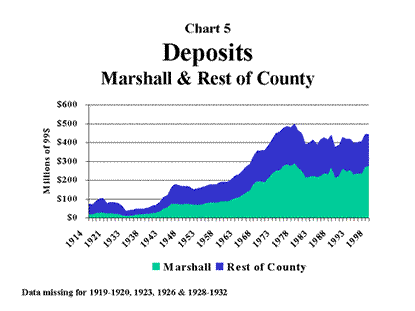
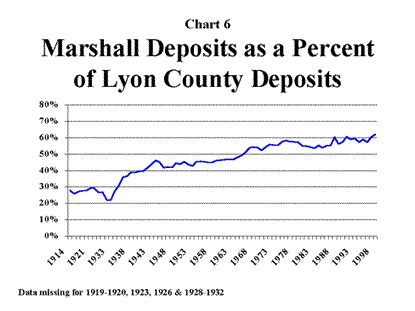
Marshall's share of Lyon County bank deposits rose gradually from around 45 percent after World War II to around 62 percent in 1998. Marshall's share was boosted by the success of Schwan's Sales Enterprises, Inc., which it began home distribution of ice cream in 1952, and by the early 1990s was Minnesota's fourth largest privately held company with business interests in 49 states, Canada and Europe. In 1967 the opening of Southwest Minnesota State College gave Marshall's deposit growth another lift.
Diversification Weakened Lyon County's Ties to Agriculture and Enabled It to Outpace the National Economy
Marshall's successes in diversifying away from agriculture loosened the grip of agricultural prices on Lyon County. Agricultural production, particularly wheat, dominated the Lyon County economy early in the century, and until about 1950 bank deposits and agricultural prices, expressed in 1999 dollars, moved in tandem. Since then, bank deposits rose until the mid-1980s while wheat and corn prices, except in the early 1970s, declined. Corn is now the principal crop in Lyon County.
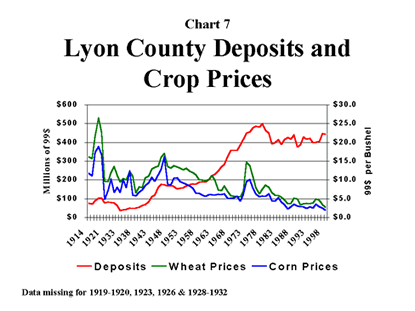
Agriculture, however, remains a major Lyon County industry. After World War II though, food processing and distribution along with higher education expanded rapidly in Marshall. As a result of economic diversification, starting around the early 1960s Lyon County deposits grew considerably faster than the national economy as measured by real gross domestic product (GDP), the nation's output of goods and services adjusted for price increases.

While total deposits depict Lyon County and Marshall's overall economic performance, per capita deposits denote changes in the well-being of county residents. Over the last 80 years, population growth has been relatively stable, but per capita deposit growth has risen.
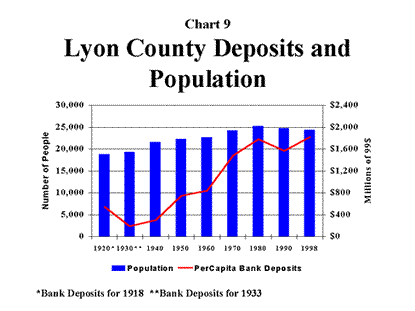
Across the county, the farm depression of the 1920s and the Great Depression substantially reduced per capita deposits. But since the 1930s, differences emerge between the rest of the county and Marshall. In the rest of the county, although population has declined, deposit growth has climbed, suggesting rising incomes have accompanied consolidation in agriculture. In Marshall the population and per capita deposit data move in same directions. The level of per-capita deposits, however, is higher in Marshall than in the rest of the county.

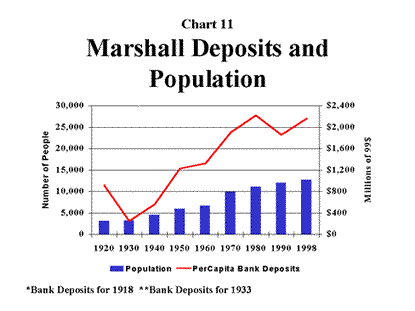
Per capita personal income data confirm that per capita deposits appear to be a rough proxy for individual economic well-being. Since 1969 per capita income data has been available for Lyon County, and in the 1970s and early 1980s, per capita deposits and per capita personal income rose and declined together. Both indicators show how the rise and fall of agricultural prices affected Lyon County. Since the mid-1980s, however, financial deregulation and innovations in the financial services industry reduced the usefulness of per capita bank deposits as an economic indicator of well-being.
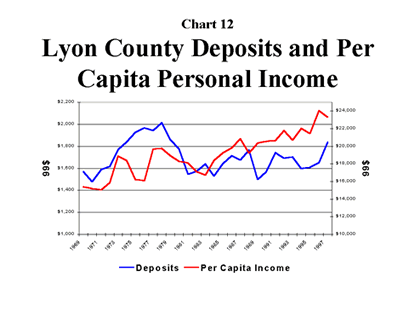
Loan-to-Deposit Ratio Portrays Lyon County Banks as Catalyst for Economic Development
While bank deposits are useful in tracing the development of Lyon County,
loans indicate the role banks played in promoting this development. Lyon
County banks initially were a primary gatekeeper for economic development,
as they had a loan-to-deposit ratio of close to 100 percent until agricultural
prices started falling after World War I. The ratio fell during the 1920s
and 1930s, but increased with the onset of World War II as agricultural
prices revived and food processing expanded in Marshall. Toward the end
of World War II, Lyon County's loan-to-deposit ratio fell again, but it
increased steadily after the war, indicating that banks have played an
important role in the diversification of Lyon County and Marshall. Falling
farm prices, however, pushed the ratio down in the 1980s.9
(Appendix 3 lists Lyon County loan-to-deposit
ratios.) [In .xls format]
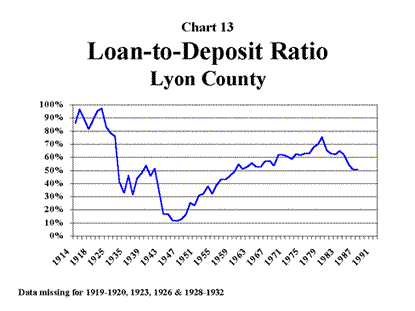
Recent loan-to-deposit ratios probably understate banks' contribution to the local economy, for banks are a primary customer for local bonds for schools, community development and industrial development projects. Lyon County banks have increased their holdings of these securities as they diversified their loan portfolios away from U. S. government bonds. In 1955 about 85 percent of their bond portfolio was in U.S. government securities, but in the late 1970s, this number had dropped to around 60 percent. Marshall banks held most of these non-U.S. government bonds.
Banks Will Remain Important to Lyon County and Marshall
As bank competitors proliferate and banks increasingly become part of regional and national organizations, are banks as important today to Lyon County and Marshall as they were in the past? Yes, the recent increase in banking offices in Marshall suggest people still need banking services, for banks remain important for financing small businesses and housing.
Moreover, banking deposit and loan data can continue to help us understand local communities, even though more local economic data are available now than in the past. Deposit data are available from the Federal Deposit Insurance Corp. (FDIC) for banking offices within the county. Also, available quarterly from the FDIC are financial statements and performance ratios for small banks whose business is conducted within the county.
In addition, the Community Reinvestment Act (CRA) requires each bank office to make available a statement indicating, on a map, the communities served by that office and the type of credit the bank is prepared to extend within the communities served. In addition, the Act requires public disclosure of a bank's CRA performance evaluations.
Conclusion
From late in the 19th century to the beginning of the 21st century, banks have been an integral part of Lyon County and its principal city, Marshall. Initially they financed the farmers and merchants who settled the region, and continued to provide funds as the county's economy diversified. As the county's economy has changed, so has its banking. Of the 18 Lyon County banks in operation in 1916, only the State Bank of Taunton has not changed its name, closed, merged or acquired branches. Nevertheless, banks continue to be a vital part of the county's economy, and connect Lyon County and Marshall to the regional, national and international economies.
Besides being key players in the county's development, Lyon County banks have left a statistical record that embellishes the county's history. Banking deposits reveal the county's rapid growth during World War I, the devastating effect of agricultural prices' collapse in the 1920s and the Great Depression, and the county economy's resurgence after World War II. Moreover, deposits disclose that the county's ties to agriculture have weakened as the Marshall economy has grown and diversified. Plus, per capita data indicate individuals in both Marshall and the rest of the county prospered after World War II.
Endnotes
1 Until March 2000, David S. Dahl was the public affairs economist in the Public Affairs Department, Federal Reserve Bank of Minneapolis. This article is based on his remarks at "Business and Banking in the Countryside", a conference sponsored by Southwest State University's Rural and Regional Studies Program, in Marshall, Minn. on Oct. 8, 1999. The views expressed are those of the author and not those of the Federal Reserve Bank of Minneapolis or the Federal Reserve System.
2 Tobin, James. Financial Intermediaries, Money, The New Palgrave (New York: W.W. Norton & Co., Inc., 1989), p. 164.
3 Webster's Seventh New Collegiate Dictionary, (Springfield, Massachusetts: G. & C. Merriam, 1970), p. 395.
4 For 1914 to 1980 bank deposit data came from Bank Directory of the Ninth Federal Reserve District from 1915 to 1928 the First and Security National Bank of Minneapolis published it and from 1933 to 1980 Commercial West, Minneapolist published it. In 1922 and 1925 editions of the American Bank Reporter, published by Steuer Publishing Co., New York, were also used. Data for 1981 to 1999 was taken from the Summary of Deposits published by the Federal Deposit Insurance Corp., both in print and on the Internet. Deposit data usually reflect year-end balances.
5 The consumer price index (CPI) was used to convert deposit data into 1999 dollars.
6 Popple, Charles, Sterling. Development of Two Bank Groups in the Central Northwest. (Cambridge, Massachusetts: Harvard University Press, 1944), p. 330.
7 Ibid., Appendices 4, 6 and 10.
8 Ibid., p. 323.
9 Loan-to-deposit ratios were computed from data from Bank Directory of the Ninth Federal Reserve District and American Bank Reporter.
Bibliography
American Bank Reporter. New York City: Steuer Publishing Co., 1922 & 1925.
Bank Directory of the Ninth Federal Reserve District. Minneapolis: Until the 1930s published by First and Security National Bank of Minneapolis and from the 1930s until the (?) by Commercial West (In 197(?) name changed to the Bank Directory of the Upper Midwest).
Case, C. F. History of Lyon County, 1884-1912. Marceline, Mo.: Walworth, 1977, Originally published: Marshall, Minn: Northern History Pub. Co., 1912.
Chucker, Harold. Banco at Fifty: A History of Northwest Bancorporation 1929-1979. Minneapolis: Northwest Bancorporation, 1979.
Kelley, Thomas J. The American National Bank and the Bremer Brothers, Ramsey County history Vol. 23, no. 1 (1988), pp 3-12.
Popple, Charles Sterling. Development of Two Bank Groups in the Central Northwest. Cambridge, Massachusetts: Harvard University Press, 1944.
Raban, Jonathan. Bad Land: An American Romance. New York: Pantheon Books, 1996.
Radzilowski, John. Prairie Town: A History of Marshall, Minnesota, 1872-1997. Marshall, Minnesota: Lyon County Historical Society, 1997.
Summary of Deposits. Washington, D.C.: Federal Deposit Insurance Corporation (FDIC), annually in print and on the Internet.
Tobin, James. Financial Intermediaries, Money, The New Palgrave. New York: W. W. Norton & Co., Inc., 1989, pp. 157-174.





